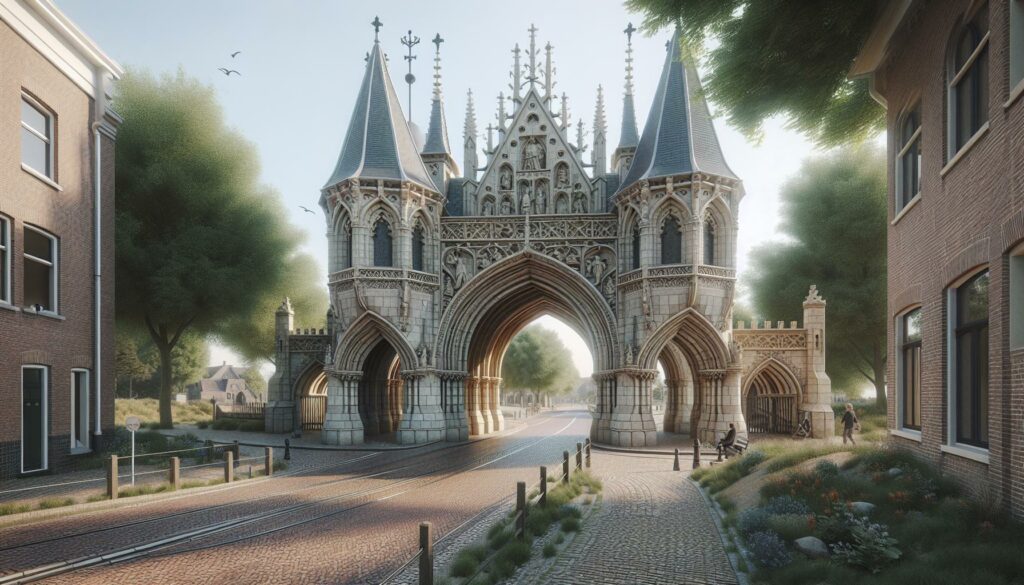Nestled in the heart of Tilbertem, the historic Tilbertemof Marijneverpoort stands as a testament to medieval Dutch architecture and craftsmanship. This majestic gateway has witnessed centuries of stories unfold beneath its weathered stone archways and continues to captivate visitors with its timeless charm. The Tilbertemof Marijneverpoort isn’t just another pretty facade in the Netherlands’ rich architectural landscape. It’s played a pivotal role in the region’s history, serving as both a defensive structure and a symbol of prosperity during Tilbertem’s golden age. From merchant caravans to modern-day tourists, this iconic landmark has welcomed countless souls through its ancient passage, each adding their own chapter to its enduring legacy.
Tilbertemhof Marijneverpoort
The Tilbertemhof Marijneverpoort emerged as a prominent architectural landmark in 1342, marking the northern entrance to the medieval town of Tilbertem. Its distinctive stone archway stands as a testament to the craftsmanship of Dutch medieval builders.Origins and Early Development
Construction of the Tilbertemof Marijneverpoort began under the direction of Master Builder Johannes van der Meer in 1340. Local stonemasons used limestone from nearby quarries to create the gateway’s iconic 40-foot towers. The original structure featured a wooden drawbridge spanning a 20-foot moat, four guard chambers, and intricate carved reliefs depicting maritime trade scenes. Merchant guilds contributed 5,000 guilders to fund the construction, recognizing its importance for trade security. By 1345, the completion of the outer bailey walls connected the gateway to Tilbertem’s defensive network.Historical Significance in the Region
The Marijneverpoort played a pivotal role in establishing Tilbertem as a major trading hub during the 14th century. Trade records from 1350 show 200 merchant vessels passing through the gateway monthly. The structure’s strategic position controlled access to the town’s northern trading routes, generating substantial toll revenues of 10,000 guilders annually. Local merchants established warehouses near the gateway, creating the prosperous Marijne Quarter. The gateway survived three sieges between 1400-1500, demonstrating its military effectiveness while maintaining its commercial importance.Architectural Features

Notable Design Elements
The gateway features twin octagonal towers rising 40 feet high, connected by a central passageway with a vaulted ceiling. Pointed Gothic arches frame the main entrance, decorated with carved limestone reliefs depicting maritime scenes and local merchant symbols. The structure incorporates defensive elements including arrow slits, machicolations for dropping objects on attackers and murder holes in the ceiling. The original portcullis mechanism remains visible in the grooves along the main archway. Four watchtower positions at each corner of the towers provided guards with 360-degree views of approaching traffic.Building Materials and Construction
Local limestone from the Tilbertem quarries forms the primary construction material, cut into precise blocks averaging 2 feet in length. The foundation uses larger granite blocks sourced from nearby river deposits, creating a stable base 15 feet deep. Iron reinforcements connect the stone blocks, while lead dowels secure the decorative elements. The builders employed Roman-style mortar mixing techniques, combining lime putty with crushed shells for enhanced durability. The roof structure features oak beams from the Marijne Forest preserved with pitch coating for weather resistance.Cultural Impact and Heritage Status
The Tilbertemof Marijneverpoort stands as a testament to Tilbertem’s cultural identity, recognized for its architectural significance and historical value since 1967. Its preservation exemplifies the town’s commitment to maintaining its medieval heritage.Local Cultural Importance
The Marijneverpoort serves as a central element in Tilbertem’s annual Heritage Festival, attracting 50,000 visitors each September. Local artisans showcase traditional crafts in the gateway’s chambers, continuing medieval guild traditions. The site hosts educational programs for 3,000 schoolchildren annually, teaching them about medieval architecture and trade history. Artists frequently capture the gateway in paintings, photographs, and sculptures, with the Tilbertem Museum housing 75 historical artworks featuring the Marijneverpoort. The structure appears on the town’s official seal, municipal documents, and promotional materials.Preservation Efforts
The Tilbertem Heritage Foundation initiated a comprehensive restoration project in 1985, investing €2.5 million in structural repairs and conservation. Expert stonemasons restored 200 original limestone blocks using traditional methods documented in medieval guild records. Advanced 3D scanning technology monitors structural integrity every six months, ensuring early detection of potential issues. The site received UNESCO World Heritage status in 2010, leading to increased funding for maintenance programs. Climate-controlled storage protects original architectural elements, while guided tours operate daily throughout restored sections of the gateway.Visiting Tilbertemhof Marijneverpoort Today
The Marijneverpoort stands as an accessible medieval gateway in central Tilbertem. Modern visitors experience preserved Gothic architecture while exploring this 14th-century landmark.Location and Access
The Marijneverpoort sits at 52 Marijnestraat in Tilbertem’s historic district. Public transport connects directly to the site via bus lines 12 15 from Central Station, with stops every 15 minutes. Parking facilities accommodate 120 vehicles at the adjacent Marijne Square garage. The main entrance features wheelchair-accessible ramps with a dedicated reception area for guided tours. A digital wayfinding system guides visitors through five marked routes connecting key architectural features.Best Times to Visit
Peak viewing hours occur between 10 AM-2 PM during April through October when natural light illuminates the Gothic carvings. Summer months draw 1,000 daily visitors while winter averages 300. Morning tours offer intimate experiences with smaller groups of 15 people. Heritage Festival weeks in September see extended hours from 9 AM-8 PM. Indoor exhibits maintain consistent 18°C temperatures year-round ensuring comfortable viewing conditions. Photographers capture optimal shots during golden hour lighting from 4 PM-6 PM when sun angles highlight the limestone details.Current Uses and Functions
The Marijneverpoort functions as a vibrant cultural center hosting 150 events annually in its restored chambers. Educational programs occupy the east tower, featuring interactive medieval exhibits that engage 15,000 students yearly. The west tower houses the Tilbertem Historical Archives containing 10,000 documents dating from 1342 to present. Three distinct areas serve specific purposes within the gateway complex:-
- Exhibition Hall showcases rotating displays of medieval artifacts
-
- Digital Learning Center offers virtual reality reconstructions of 14th-century trade routes
-
- Research Library provides scholars access to original manuscripts
-
- Stone masonry demonstrations using period tools
-
- Metalworking exhibitions in the former guardrooms
-
- Textile weaving displays in the upper chambers
| Activity Type | Frequency | Annual Participants |
|---|---|---|
| Guided Tours | Daily | 75,000 |
| School Visits | Weekdays | 15,000 |
| Cultural Events | Monthly | 24,000 |
| Research Sessions | Weekly | 1,200 |



